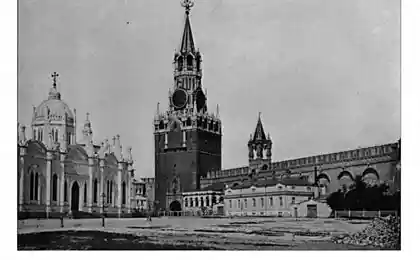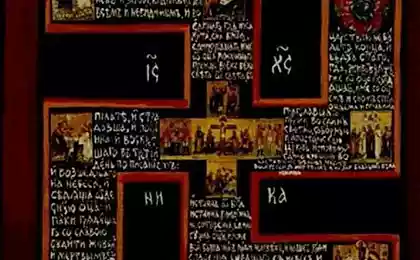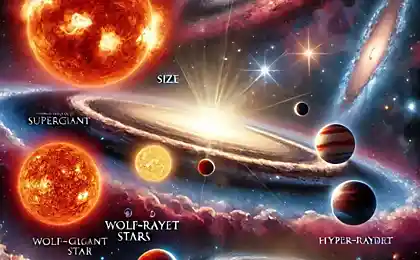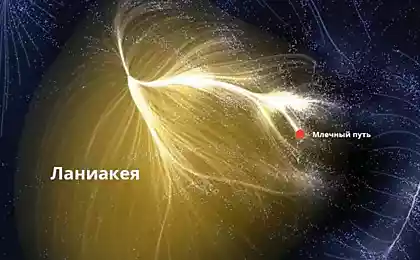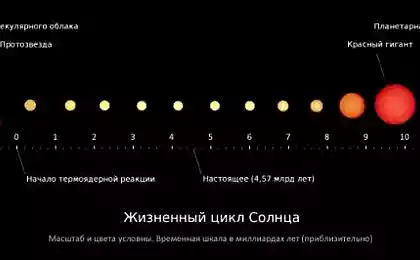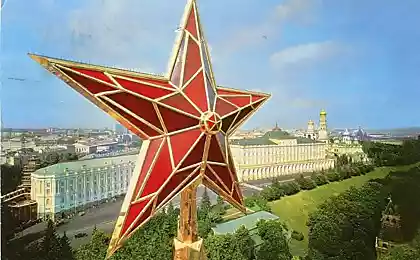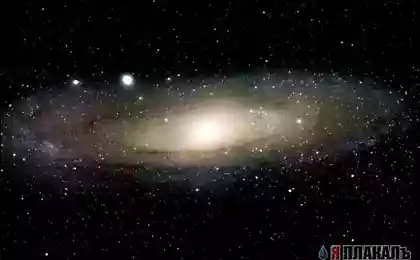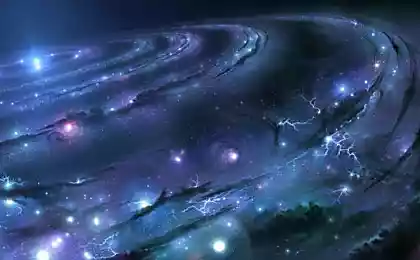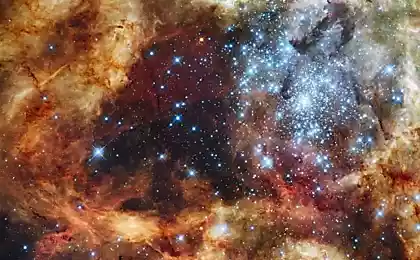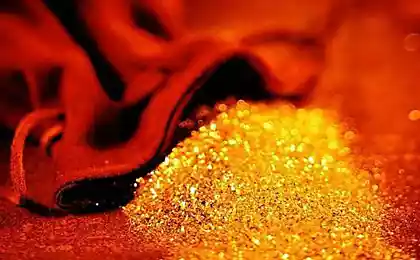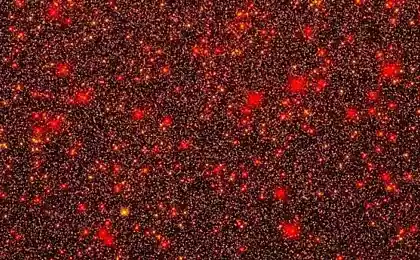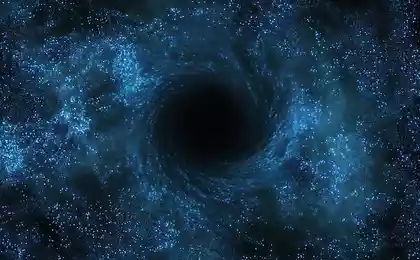1445
History of the Kremlin stars (24 photos)
The stars on the towers of the Kremlin appeared not so long ago. Until 1935 in the heart of the country of victorious socialism still adorned gilded characters tsarist double-headed eagles. Under the cut is not an easy story Kremlin stars and eagles.

Since the 1600s the four towers of the Kremlin (the Trinity, the Saviour, and Nicholas Borovitskaya) decorated with symbols of the Russian state - the huge gilded two-headed eagles. Eagles these are not perched on the spire of the centuries - they change quite often (after all, still some researchers argue from what they were material - metal or gilded wood; there is evidence that the body of some eagles - if not all - it was wooden, and other details - metal, but it is logical to assume that those first two-headed birds, were made entirely of wood).

This fact - the fact of the constant rotation of capstan jewelry - to remember, because it was he who later will play a major role during the replacement of the Eagles at the stars.
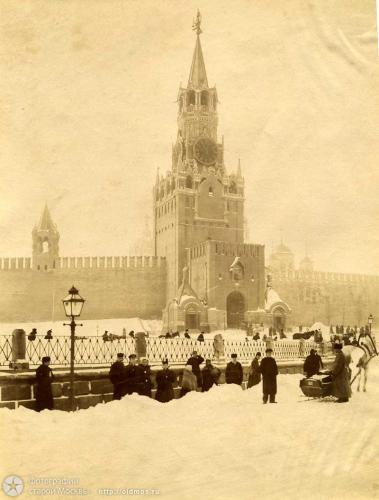
In the first years of Soviet power all the double-headed eagles in the country were destroyed, all except four. Four gilded eagle sitting on the towers of the Moscow Kremlin. The issue of replacing the royal eagles red stars on the Kremlin towers repeatedly arose soon after the revolution. However, this change was associated with high expenditures and therefore could not be held in the first years of Soviet power.
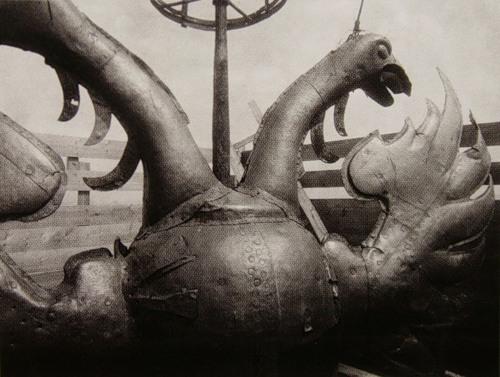
A real opportunity to allocate funds for the installation of the stars on the Kremlin towers appeared much later. In 1930, he appealed to the artists and art Igor Grabar asking you to set artistic and historical value Kremlin eagles. He said: & quot; ... none of the currently existing on the Kremlin towers eagles is not an ancient monument and as such can not defend & quot ;.
Parade of 1935. The Eagles flies look like Maxim Gorky and spoil the celebration of Soviet power.
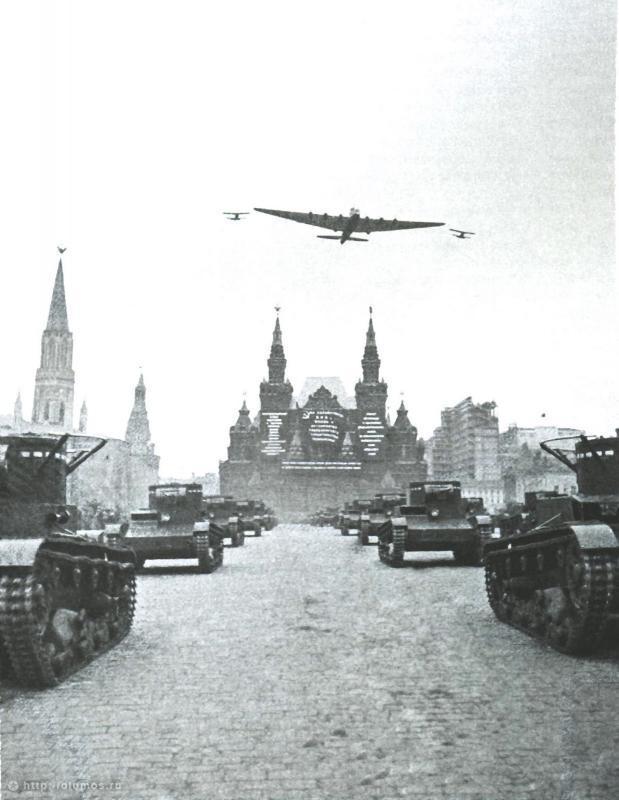
In August 1935, in the central press published the following message Tass: "Council of People's Commissars, the Central Committee of the CPSU (b) decided to November 7, 1935 4 Eagle lift, located on the Saviour, St. Nicholas, Borovitskaya, Trinity Tower Kremlin wall and 2 Eagle of the building of the Historical Museum. By that same date, it decided to set these four towers of the Kremlin five-pointed star with hammer and sickle. "
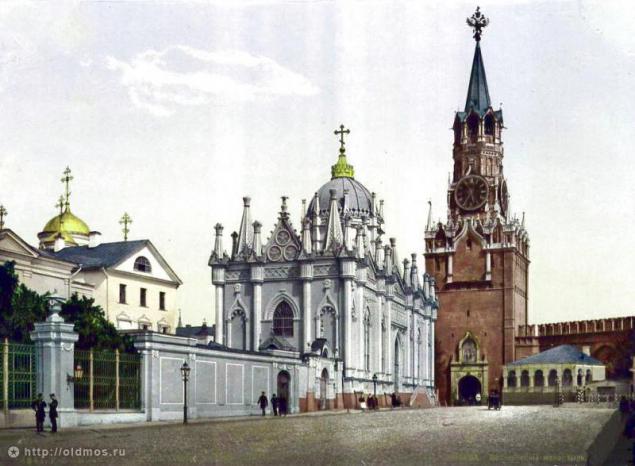
And eagles removed.

...
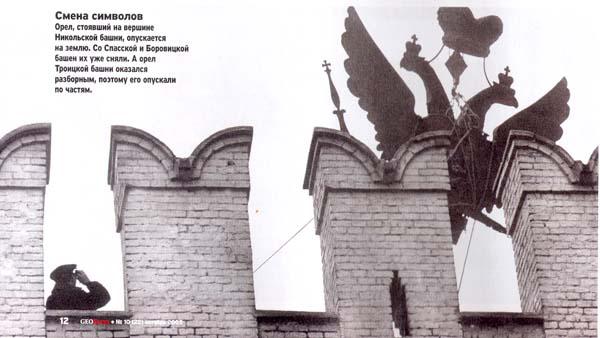
Design and production of the first stars of the Kremlin was entrusted to two Moscow factories and workshops Central hydrodynamic Institute (TsAGI). Outstanding designer, academician Fyodor Fedorov started to develop sketches of future stars. He determined their shape, size, pattern. The Kremlin decided to make a star of high-alloy stainless steel and red copper. In the middle of each star, both sides were lined with sparkle of precious stones emblem of hammer and sickle. When the sketches were created, produced models of full-size star. Hammer and sickle emblems temporarily imitations encrusted jewels. Each star-lit layout of twelve spotlights. That is expected to cover the real stars on the Kremlin towers at night and on cloudy days. When turned on spotlights, stars sparkled and flashed a myriad of colored lights.
Inspect the finished models came leaders of the party and the Soviet government. They agreed on the production of stars with an indispensable condition - to make them rotate, to Muscovites and visitors can admire them from anywhere.
The work on creation of the Kremlin stars was attended by hundreds of people of various specialties. For the Saviour and Trinity Towers Star TSAGI produced in workshops led by Chief Engineer Institute AA Arkhangelsk, while Nicholas and Borovitskaya - at the Moscow plant under the supervision of the chief designer.
All four stars differ from each other decoration. So, on the faces of the stars of the Spasskaya tower were rays emanating from the center. In the rays of the star of the Trinity tower were made in the form of spikes. Star Borovitskaya tower consisted of two circuit inscribed one into another. And the rays of the star pattern Nikolskaya tower had.
Stars Spasskaya and Nikolskaya towers were similar in magnitude. The distance between the ends of beams was 4, 5 meters. Stars Trinity and Borovitskaya towers were smaller. The distance between the ends of beams was respectively 4 and 3, 5 meters.
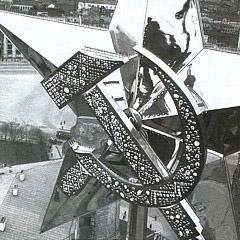
The supporting structure of stars performed as a lightweight, durable stainless steel frame. This framework imposed framing ornaments of red copper sheets. They were covered with a gold thickness of 18 to 20 microns. Each star on both sides strengthened the hammer and sickle emblem of the size of 2 meters and a weight of 240 kilograms. Posters were decorated with precious stones of the Urals - rock crystal, amethyst, alexandrite, topaz and aquamarine. For the production of the eight emblems took about 7000 stones in size from 20 to 200 carats (one carat is equal to 0, 2 g.) From the report paupers employee Operations Division of the NKVD: "Every stone faceted diamond Galley (73 faces), and reduce the risk of embedded a separate caste silver with silver screw and nut. The total weight of all stars - 5600 kg. ».
Star for the Nikolskaya Tower. 1935. ph. B.Vdovenko.

Frame posters was made of bronze and stainless steel. This frame was attached separately each gem mounted in gilded silver. Two hundred and fifty of the best jewelers in Moscow and Leningrad and a half months of work on the creation of logos. The principles were developed by the arrangement of stones Leningrad artists.
The design of the stars has been designed to load hurricane. At the base of each star we have established special bearings manufactured at the First Bearing Plant. Thanks to this star, despite significant weight can easily rotate and become its front side against the wind
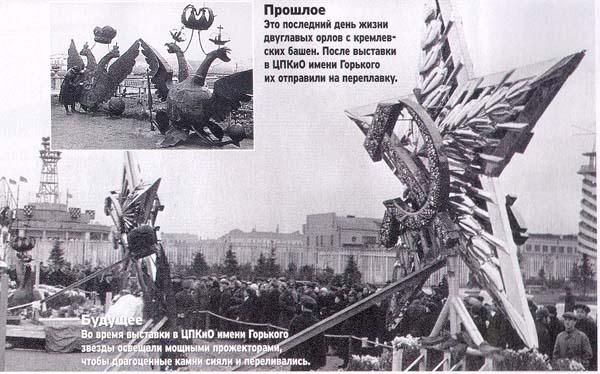
Before installing the stars on the Kremlin towers engineers doubt: the tower will stand whether their severity and storm wind loads? For every star weighing an average of one thousand kilograms and was sailing in the surface 6, 3 square meters. Careful studies have shown that the upper floors of towers and domes of the tents came to the dilapidated state. It was necessary to strengthen the masonry of the upper floors of the towers, which had set the stars. In addition, the tents of the Saviour, Trinity and Borovitskaya towers additionally introduced metallic bonds. A tent Nikolskaya tower was so dilapidated that it had to build anew.

Now the experts of the All-Union Bureau Stalprommehanizatsiya LN Schipakovym, IV Kuneginym, NB Gitmanom and II Rechetov got an important task - to pick up and set the stars on the Kremlin towers. But how? It is the lowest of them, Borovitskaya, has a height of 52 meters, and the highest, Trinity - 77 meters. While large crane was not, specialists Stalprommehanizatsii found an original solution. They are designed and built for each tower a special crane, which can be installed on its top tier. At the base of the tent through the turret window was inserted into a metal base - console. It's the collected crane.
The day when everything was ready to rise five-pointed stars. But before they decided to show the Muscovites. October 23, 1935 the star was taken to the Central Park of Culture and Rest. Gorky and set on pedestals, upholstered in red cloth. In the spotlight shone with gold rays sparkled Ural gems. Inspect the stars arrived secretaries of city and district committees of the CPSU (b), the chairman of the Moscow City Council. The park came hundreds of Muscovites. Everyone wanted to enjoy the beauty and majesty of the stars that were soon to erupt in the sky of Moscow.
Remove the Eagles put on display there.

October 24, 1935 on the Spasskaya Tower installed the first star. Before lifting it carefully polished with a soft cloth. At this time, the mechanics and checked winch motor crane. At 12 hours and 40 minutes later there was a team, "Veera little!" Star off the ground and slowly began to climb. When she was at the height of 70 meters, the machine stopped. Standing on the top of the tower climbers carefully picked and sent a star on the spire. In 13 hours and 30 minutes Star goes right to the reference pin. Witnesses recall that day in Red Square gathered several hundred people who were watching the operation. At the time when the star appeared on the spire, the whole crowd started cheering climbers.
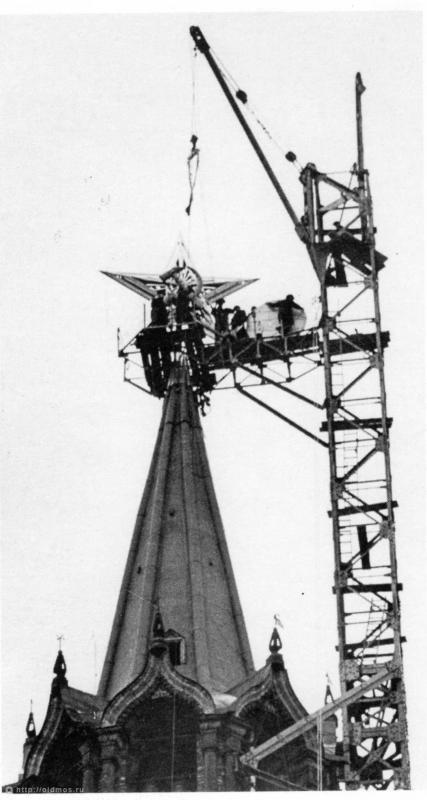
The next day, five-pointed star was installed on the spire of Trinity Tower. 26 and 27 October the stars shone above and Borovitskaya Nikolskaya towers. Installers worked as lifting equipment that they needed to install each star no more than one and a half hours. The exception was the star of the Trinity Tower, the rise is due to the strong wind lasted about two hours. Since then, both newspapers published a decree on setting stars, a little more than two months. To be exact - only 65 days. Newspapers wrote about the labor heroism of Soviet workers, who for a short period of time create a work of art.
Star with Spassky Tower is now crowned spire River Station.
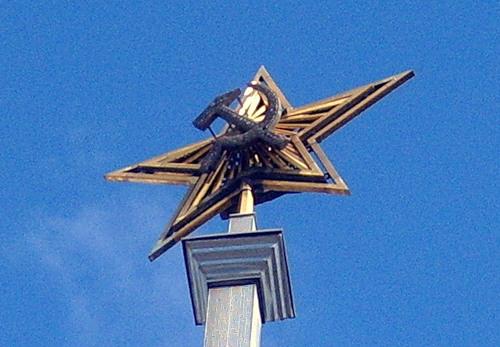
The first stars long adorned the tower of the Moscow Kremlin. One year later, under the influence of precipitation faded Ural gems. In addition, they are not fully fit into the architectural ensemble of the Kremlin because of its large size. Therefore in May 1937 it was decided to establish the new stars - glowing, ruby. Then the four towers with stars added another one - Vodovzvodnaya. Chief engineer for the design and installation of the stars was appointed Professor Alexander Landa (Fishelevich). In Samara, still kept his project - five massive albums of drawings in red bindings. They say that no less impressive than the stars themselves.
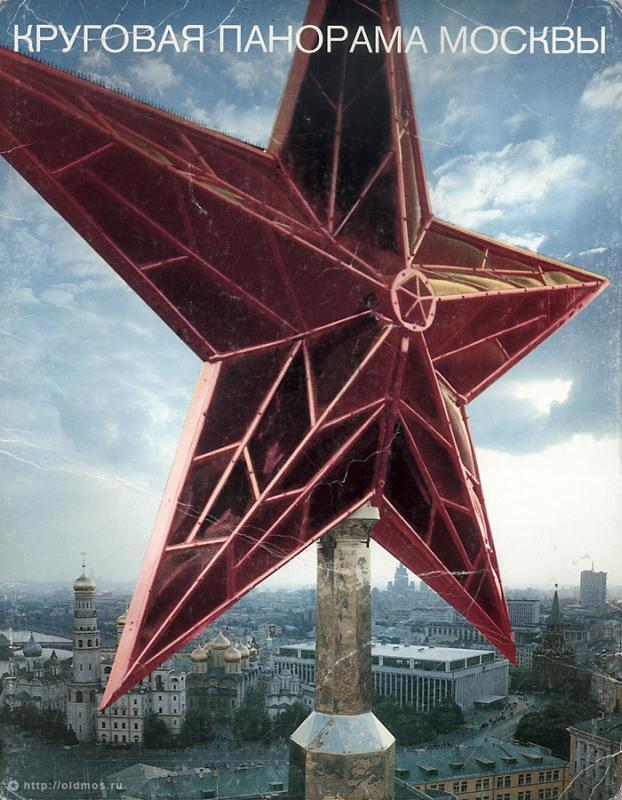
Ruby glass was welded to the glass factory in Konstantinovka, prescription Moscow steklovara N. Kurochkin. We had to cook 500 square meters of ruby glass, which was invented a new technology - "Selenium Ruby". Before that, to achieve the desired color in the glass added to gold; Selenium - a cheaper and more deeper color. At the base of each star we have established special bearings, so that they, in spite of the severity could be rotated like a weathercock. They are not afraid of rust hurricane as "rim" star is made of special stainless steel. The principal difference: weathervanes indicate where the wind blows, and the Kremlin stars - where. We understand the nature and significance of the fact? Due to the diamond-shaped cross-section of the star she always gets hard forehead against the wind. And any - up to a hurricane. Even if all will carry around and cleaned, the star and the tents will remain tselehonkim. So I designed and built.
But suddenly revealed the following: in the sunlight ruby stars seem to be ... black. The answer was found - five-pointed beauties had to do double-layer and the bottom, the inner layer of glass should be milky white, well-scatter light. By the way, it provides a smooth and glowing, and hiding from the eyes of filament lamps. By the way, there is also a dilemma - how to make a smooth glow? After all, if the lamp is installed in the center of the star, the rays are likely to be less bright. Helped combination of different thickness and color saturation of the glass. Furthermore, lamps enclosed in glass consisting of prismatic refractors tiles.
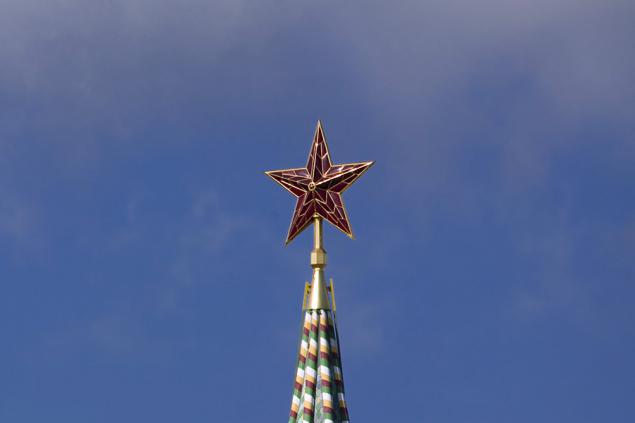
From high-power lamps (up to 5000 watts) raskochegarivalas temperature inside stars, in the locomotive firebox. The heat threatens to destroy themselves and the bulb, and the five-pointed precious rubies. The professor wrote: "It is clear that we can not allow bursting or cracking of the glass in case of rain or changes in the weather and falling glass down. Fans operate smoothly. After the star passed about 600 cubic meters of air per hour, which fully guarantees from overheating. " The five-pointed luminaries does not threaten the Kremlin off electricity as their energy is produced autonomously.
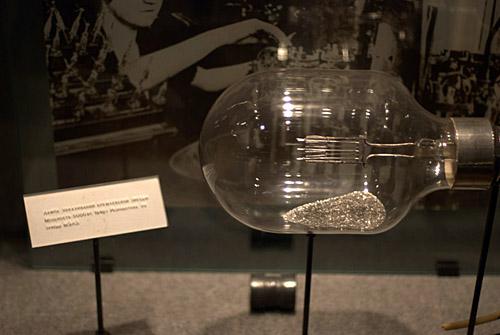
Lamps for the Kremlin stars worked at the Moscow Electrical Lamp Plant. Power of three - on the Spasskaya, Nikolskaya and Troitskaya Tower - 5000 watts and 3700 watts - on Borovitskaya and Vodovzvodnaya. In each installed two filament connected in parallel. If the fuse continues to burn a lamp, and the control panel receives a fault signal. An interesting mechanism for changing the lamps: the star did not have to rise, the lamp goes down on a special rod right through the bearing. On the whole procedure requires 30-35 minutes.
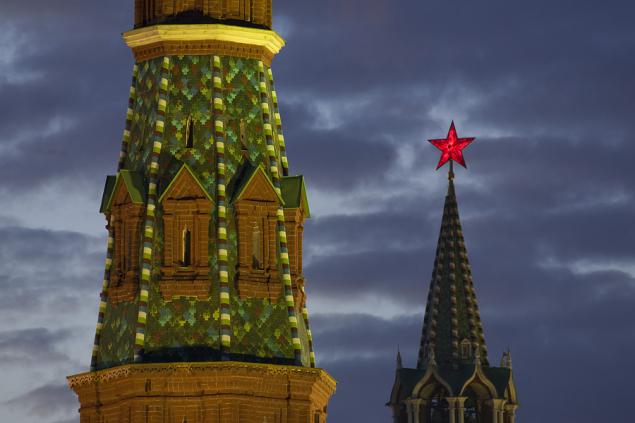
In the history of the stars went out only 2 times. The first time, during the Second World War. It was then that the first stars were extinguished - they were not only a symbol but also an excellent beacon-guide. Closed sacking, they waited patiently for the bombing, and when it was over, it turned out that the glass in many places damaged and requires replacement. And pests inadvertently turned his well - gunners to defend the capital from the Nazi air raids. The second time when Nikita Mikhalkov in 1997 shot his "The Barber of Siberia».
The center console control and management of ventilation stars is located in Trinity Tower of the Kremlin. There are the most modern equipment. Every day, twice a day, visually check the lamp operation, as well as to switch their fans blowing.
Every five years, the stars of glass wash industrial climbers.
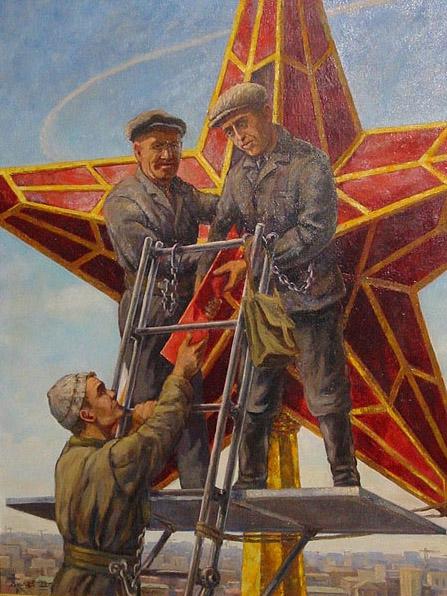
...

...
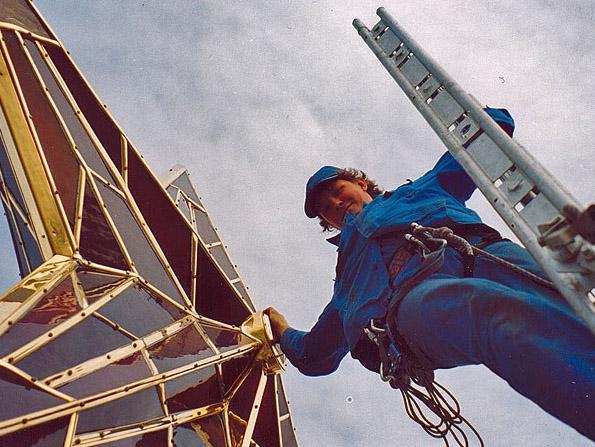
Since the 1990's, being the public debate about the appropriateness of Soviet symbols in the Kremlin. In particular, the Russian Orthodox Church and a number of patriotic organizations hold a categorical stance, saying "it would be fair to return to the Kremlin towers double eagles, which they decorated for centuries».
via zyalt
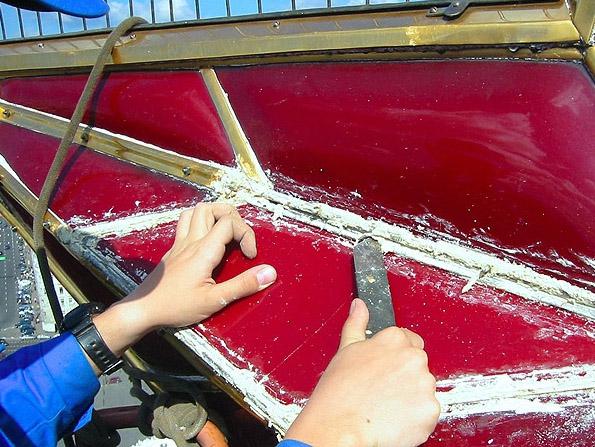
Source:

Since the 1600s the four towers of the Kremlin (the Trinity, the Saviour, and Nicholas Borovitskaya) decorated with symbols of the Russian state - the huge gilded two-headed eagles. Eagles these are not perched on the spire of the centuries - they change quite often (after all, still some researchers argue from what they were material - metal or gilded wood; there is evidence that the body of some eagles - if not all - it was wooden, and other details - metal, but it is logical to assume that those first two-headed birds, were made entirely of wood).

This fact - the fact of the constant rotation of capstan jewelry - to remember, because it was he who later will play a major role during the replacement of the Eagles at the stars.

In the first years of Soviet power all the double-headed eagles in the country were destroyed, all except four. Four gilded eagle sitting on the towers of the Moscow Kremlin. The issue of replacing the royal eagles red stars on the Kremlin towers repeatedly arose soon after the revolution. However, this change was associated with high expenditures and therefore could not be held in the first years of Soviet power.

A real opportunity to allocate funds for the installation of the stars on the Kremlin towers appeared much later. In 1930, he appealed to the artists and art Igor Grabar asking you to set artistic and historical value Kremlin eagles. He said: & quot; ... none of the currently existing on the Kremlin towers eagles is not an ancient monument and as such can not defend & quot ;.
Parade of 1935. The Eagles flies look like Maxim Gorky and spoil the celebration of Soviet power.

In August 1935, in the central press published the following message Tass: "Council of People's Commissars, the Central Committee of the CPSU (b) decided to November 7, 1935 4 Eagle lift, located on the Saviour, St. Nicholas, Borovitskaya, Trinity Tower Kremlin wall and 2 Eagle of the building of the Historical Museum. By that same date, it decided to set these four towers of the Kremlin five-pointed star with hammer and sickle. "

And eagles removed.

...

Design and production of the first stars of the Kremlin was entrusted to two Moscow factories and workshops Central hydrodynamic Institute (TsAGI). Outstanding designer, academician Fyodor Fedorov started to develop sketches of future stars. He determined their shape, size, pattern. The Kremlin decided to make a star of high-alloy stainless steel and red copper. In the middle of each star, both sides were lined with sparkle of precious stones emblem of hammer and sickle. When the sketches were created, produced models of full-size star. Hammer and sickle emblems temporarily imitations encrusted jewels. Each star-lit layout of twelve spotlights. That is expected to cover the real stars on the Kremlin towers at night and on cloudy days. When turned on spotlights, stars sparkled and flashed a myriad of colored lights.
Inspect the finished models came leaders of the party and the Soviet government. They agreed on the production of stars with an indispensable condition - to make them rotate, to Muscovites and visitors can admire them from anywhere.
The work on creation of the Kremlin stars was attended by hundreds of people of various specialties. For the Saviour and Trinity Towers Star TSAGI produced in workshops led by Chief Engineer Institute AA Arkhangelsk, while Nicholas and Borovitskaya - at the Moscow plant under the supervision of the chief designer.
All four stars differ from each other decoration. So, on the faces of the stars of the Spasskaya tower were rays emanating from the center. In the rays of the star of the Trinity tower were made in the form of spikes. Star Borovitskaya tower consisted of two circuit inscribed one into another. And the rays of the star pattern Nikolskaya tower had.
Stars Spasskaya and Nikolskaya towers were similar in magnitude. The distance between the ends of beams was 4, 5 meters. Stars Trinity and Borovitskaya towers were smaller. The distance between the ends of beams was respectively 4 and 3, 5 meters.

The supporting structure of stars performed as a lightweight, durable stainless steel frame. This framework imposed framing ornaments of red copper sheets. They were covered with a gold thickness of 18 to 20 microns. Each star on both sides strengthened the hammer and sickle emblem of the size of 2 meters and a weight of 240 kilograms. Posters were decorated with precious stones of the Urals - rock crystal, amethyst, alexandrite, topaz and aquamarine. For the production of the eight emblems took about 7000 stones in size from 20 to 200 carats (one carat is equal to 0, 2 g.) From the report paupers employee Operations Division of the NKVD: "Every stone faceted diamond Galley (73 faces), and reduce the risk of embedded a separate caste silver with silver screw and nut. The total weight of all stars - 5600 kg. ».
Star for the Nikolskaya Tower. 1935. ph. B.Vdovenko.

Frame posters was made of bronze and stainless steel. This frame was attached separately each gem mounted in gilded silver. Two hundred and fifty of the best jewelers in Moscow and Leningrad and a half months of work on the creation of logos. The principles were developed by the arrangement of stones Leningrad artists.
The design of the stars has been designed to load hurricane. At the base of each star we have established special bearings manufactured at the First Bearing Plant. Thanks to this star, despite significant weight can easily rotate and become its front side against the wind

Before installing the stars on the Kremlin towers engineers doubt: the tower will stand whether their severity and storm wind loads? For every star weighing an average of one thousand kilograms and was sailing in the surface 6, 3 square meters. Careful studies have shown that the upper floors of towers and domes of the tents came to the dilapidated state. It was necessary to strengthen the masonry of the upper floors of the towers, which had set the stars. In addition, the tents of the Saviour, Trinity and Borovitskaya towers additionally introduced metallic bonds. A tent Nikolskaya tower was so dilapidated that it had to build anew.

Now the experts of the All-Union Bureau Stalprommehanizatsiya LN Schipakovym, IV Kuneginym, NB Gitmanom and II Rechetov got an important task - to pick up and set the stars on the Kremlin towers. But how? It is the lowest of them, Borovitskaya, has a height of 52 meters, and the highest, Trinity - 77 meters. While large crane was not, specialists Stalprommehanizatsii found an original solution. They are designed and built for each tower a special crane, which can be installed on its top tier. At the base of the tent through the turret window was inserted into a metal base - console. It's the collected crane.
The day when everything was ready to rise five-pointed stars. But before they decided to show the Muscovites. October 23, 1935 the star was taken to the Central Park of Culture and Rest. Gorky and set on pedestals, upholstered in red cloth. In the spotlight shone with gold rays sparkled Ural gems. Inspect the stars arrived secretaries of city and district committees of the CPSU (b), the chairman of the Moscow City Council. The park came hundreds of Muscovites. Everyone wanted to enjoy the beauty and majesty of the stars that were soon to erupt in the sky of Moscow.
Remove the Eagles put on display there.

October 24, 1935 on the Spasskaya Tower installed the first star. Before lifting it carefully polished with a soft cloth. At this time, the mechanics and checked winch motor crane. At 12 hours and 40 minutes later there was a team, "Veera little!" Star off the ground and slowly began to climb. When she was at the height of 70 meters, the machine stopped. Standing on the top of the tower climbers carefully picked and sent a star on the spire. In 13 hours and 30 minutes Star goes right to the reference pin. Witnesses recall that day in Red Square gathered several hundred people who were watching the operation. At the time when the star appeared on the spire, the whole crowd started cheering climbers.

The next day, five-pointed star was installed on the spire of Trinity Tower. 26 and 27 October the stars shone above and Borovitskaya Nikolskaya towers. Installers worked as lifting equipment that they needed to install each star no more than one and a half hours. The exception was the star of the Trinity Tower, the rise is due to the strong wind lasted about two hours. Since then, both newspapers published a decree on setting stars, a little more than two months. To be exact - only 65 days. Newspapers wrote about the labor heroism of Soviet workers, who for a short period of time create a work of art.
Star with Spassky Tower is now crowned spire River Station.

The first stars long adorned the tower of the Moscow Kremlin. One year later, under the influence of precipitation faded Ural gems. In addition, they are not fully fit into the architectural ensemble of the Kremlin because of its large size. Therefore in May 1937 it was decided to establish the new stars - glowing, ruby. Then the four towers with stars added another one - Vodovzvodnaya. Chief engineer for the design and installation of the stars was appointed Professor Alexander Landa (Fishelevich). In Samara, still kept his project - five massive albums of drawings in red bindings. They say that no less impressive than the stars themselves.

Ruby glass was welded to the glass factory in Konstantinovka, prescription Moscow steklovara N. Kurochkin. We had to cook 500 square meters of ruby glass, which was invented a new technology - "Selenium Ruby". Before that, to achieve the desired color in the glass added to gold; Selenium - a cheaper and more deeper color. At the base of each star we have established special bearings, so that they, in spite of the severity could be rotated like a weathercock. They are not afraid of rust hurricane as "rim" star is made of special stainless steel. The principal difference: weathervanes indicate where the wind blows, and the Kremlin stars - where. We understand the nature and significance of the fact? Due to the diamond-shaped cross-section of the star she always gets hard forehead against the wind. And any - up to a hurricane. Even if all will carry around and cleaned, the star and the tents will remain tselehonkim. So I designed and built.
But suddenly revealed the following: in the sunlight ruby stars seem to be ... black. The answer was found - five-pointed beauties had to do double-layer and the bottom, the inner layer of glass should be milky white, well-scatter light. By the way, it provides a smooth and glowing, and hiding from the eyes of filament lamps. By the way, there is also a dilemma - how to make a smooth glow? After all, if the lamp is installed in the center of the star, the rays are likely to be less bright. Helped combination of different thickness and color saturation of the glass. Furthermore, lamps enclosed in glass consisting of prismatic refractors tiles.

From high-power lamps (up to 5000 watts) raskochegarivalas temperature inside stars, in the locomotive firebox. The heat threatens to destroy themselves and the bulb, and the five-pointed precious rubies. The professor wrote: "It is clear that we can not allow bursting or cracking of the glass in case of rain or changes in the weather and falling glass down. Fans operate smoothly. After the star passed about 600 cubic meters of air per hour, which fully guarantees from overheating. " The five-pointed luminaries does not threaten the Kremlin off electricity as their energy is produced autonomously.

Lamps for the Kremlin stars worked at the Moscow Electrical Lamp Plant. Power of three - on the Spasskaya, Nikolskaya and Troitskaya Tower - 5000 watts and 3700 watts - on Borovitskaya and Vodovzvodnaya. In each installed two filament connected in parallel. If the fuse continues to burn a lamp, and the control panel receives a fault signal. An interesting mechanism for changing the lamps: the star did not have to rise, the lamp goes down on a special rod right through the bearing. On the whole procedure requires 30-35 minutes.

In the history of the stars went out only 2 times. The first time, during the Second World War. It was then that the first stars were extinguished - they were not only a symbol but also an excellent beacon-guide. Closed sacking, they waited patiently for the bombing, and when it was over, it turned out that the glass in many places damaged and requires replacement. And pests inadvertently turned his well - gunners to defend the capital from the Nazi air raids. The second time when Nikita Mikhalkov in 1997 shot his "The Barber of Siberia».
The center console control and management of ventilation stars is located in Trinity Tower of the Kremlin. There are the most modern equipment. Every day, twice a day, visually check the lamp operation, as well as to switch their fans blowing.
Every five years, the stars of glass wash industrial climbers.

...

...

Since the 1990's, being the public debate about the appropriateness of Soviet symbols in the Kremlin. In particular, the Russian Orthodox Church and a number of patriotic organizations hold a categorical stance, saying "it would be fair to return to the Kremlin towers double eagles, which they decorated for centuries».
via zyalt

Source:
